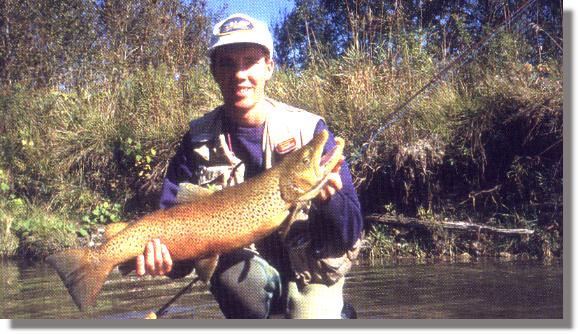Migratory Browns
By Chris Marshall
From an Interview of Glen Hales, Associate Photo Editor,
The Canadian Fly Fisher
Locating Fish
One of the prime rules of fishing for migratory browns on small
streams is that the fly fisher has to be prepared to spend more time looking
than fishing. There is little point in casting blind and hoping that a brown
might hit.
Many of the tributaries draw crowds of anglers while salmon and trout
are running, and most pools can be crowded. If this is the case, there's not
much sense in joining the crowds around the pools: not only is it difficult
to cast a fly in a crowd, but any self-respecting brown will have buried itself
deep in cover. In such circumstances, the fly fisher should seek out the less
obvious places, such as small less popular pools and the pockets in runs.
For instance, a number of north shore tributaries run over ledges of flat
limestone in their lower reaches. There is one popular tributary which has
a series of such ledges right in the middle of the town just above where the
flow enters the lake. These form a succesion of low, broad steps, interspersed
with turbulent pools and pockets. The browns frequently hold here as they
make their first foray upstream. Yet most anglers ignore these places, preferring
to concentrate on the deeper, smoother water downstream.
A little careful scouting is usually all that is needed to located similar underfished
pocket water on most streams. Such pockets are much more likely to hold browns
when they're on the move - between sunset and a couple of hours after sunrise
and when the water is running higher and with a touch of colour after a rain.
Bigger Pools and Runs
You won't always find that the main pools and runs are crowded,
especially on weekdays. There are far fewer anglers on the stream
in the fall than there are during the rainbow run in the spring. And
there are even fewer once the chinook run has passed its peak by
mid-September. This leaves them open for the fly fisher.

The obvious places for browns in bigger pools and runs is in or
adjacent to cover, and in or at the edge of a flow. Check out undercut
banks, overhanging tree roots, rocks, rock ledges, logs parallel to the
bank, and log jams. In the deeper pools, they'll sometimes hold in
relatively open water, especially if the pool has not been disturbed for
some time by other anglers. The same goes for the heads of pools
and runs where there is turbulence and foam. During the time that
there are pods of chinook in the stream, browns will frequently hold
just at the downstream edge of the pod. This is partly because they're
using the larger bulk of the chinook for cover, and partly because they
will actively feed on chinook eggs. In very low light conditions, you'll
sometimes find them holding in the shallower water at the tail.
The Approach
For the most part, in order to catch migratory browns on small streams you
have to spot them first. This means you have to be sneaky. You have to
spot the fish before they spot you. Poloroid glasses are essential for the former,
and drab clothing is essential for the latter. Unlike pacific salmon, which will
hold in plain sight even when a pool is surrounded by anglers chucking hardware
at them, browns quickly fade away into cover when disturbed. This means you
have to approach potential holding areas from downstream, and that you have to
move slowly, avoid clumping and stumbling feet, keep a low profile, and
utilize bankside cover as carefully as you would when approaching a rising
resident trout during the hatch. ~ Chris Marshall
 Next time, Presentation and the Tackle.
Next time, Presentation and the Tackle.
We thank the Canadian Fly Fisher for re-print permission!
Our Man In Canada Archives
|



 Next time, Presentation and the Tackle.
Next time, Presentation and the Tackle.